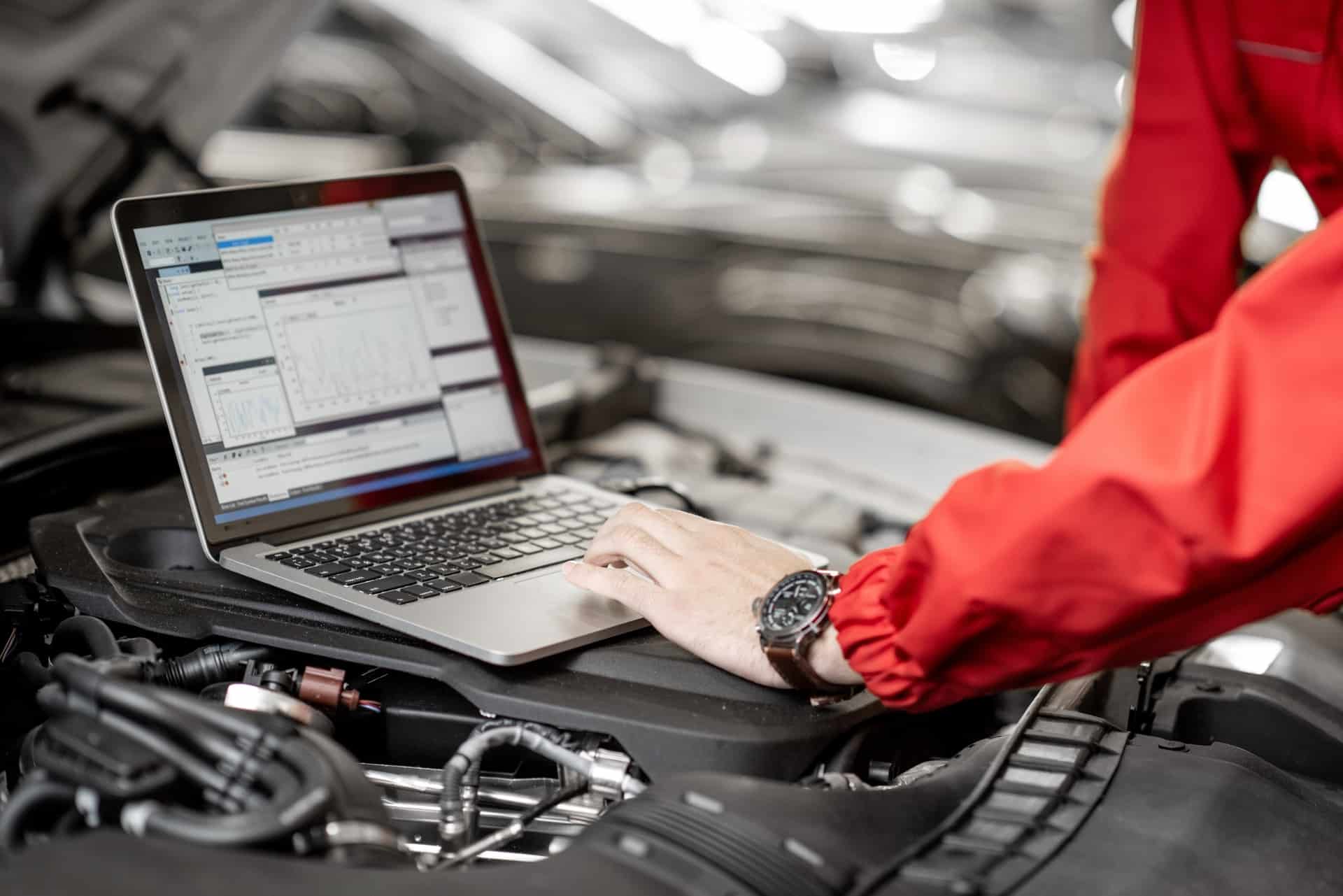Car Diagnostics
“Just plug in our scanner and we’ll know exactly what’s wrong in minutes.”
Those seemingly reassuring words mark the beginning of an expensive journey we see far too often at Roade Main Garage. New customers arrive at our Northampton workshop feeling frustrated and betrayed, their bank accounts lighter by hundreds of pounds, with those same warning lights still mockingly illuminated on their dashboard.
Their stories follow a painfully familiar pattern: A quick scan at another garage, a hasty diagnosis, “just needs this £300 part replaced.” But within days? That warning light blazes back to life. Another “simple fix” attempted, another £400 gone. Before they realise what’s happening, they’re £700 poorer, and their vehicle isn’t just unrepaired – it might be performing worse than when this costly ordeal began.
This expensive cycle stems from garages that rely solely on fault codes instead of conducting a thorough diagnostic evaluation. At Roade Main Garage, we follow a methodical process that identifies the root cause first time – protecting you from that costly spiral of trial-and-error repairs.
Before we reveal our comprehensive diagnostic evaluation process, let’s address some widespread misconceptions about car diagnostics that might be costing you money.

Common Misconceptions About Car Diagnostics
“Just clear the code and it’ll be fine…”
This dangerous misconception often leads to bigger problems. Clearing a fault code without addressing the underlying issue is like disconnecting your smoke alarm because it’s beeping. The warning exists for a reason – and it will return if the real problem isn’t resolved. Professional car diagnostics identifies and resolves the root cause, not just the symptoms.
“Can’t you just plug in a computer and tell me what’s wrong?”
This might be our most frequently heard question at Roade Main Garage. The simple answer is no – a fault code is merely a symptom, not a diagnosis.
Think about visiting A&E with severe joint pain. Would you expect treatment based solely on where it hurts? Of course not. The medical team would check your movement, run blood tests, examine other symptoms, and consider your medical history before determining the true cause. Your vehicle deserves the same thorough diagnostic evaluation approach.
“My mate has a code reader – surely that’s all I need?”
Ever wondered why technical specialists like us invest thousands in sophisticated diagnostic equipment when basic code readers are readily available? Here’s the reality – whilst basic scanners can identify simple fault codes, professional tools access manufacturer-specific codes, live data streams, and advanced testing capabilities. Many modern vehicles actually have multiple computer systems, but basic scanners typically only communicate with one!
Think of it like comparing a home blood pressure monitor to a hospital’s advanced diagnostic suite – there’s simply no comparison in terms of depth and accuracy.
“How much will it cost to fix fault code Pxxxx?”
We hear this question frequently at our Northampton workshop, but providing an accurate repair quote based solely on a fault code is impossible. The same code can indicate multiple different issues, each requiring different solutions and carrying vastly different repair costs.
Think about calling your GP about a persistent cough – without proper examination, there’s no way to know if it’s just a cold, allergies, or something that needs antibiotics. Each possible cause needs a different treatment, and you wouldn’t want to take the wrong medicine.
What Really Happens During Our Professional Car Diagnostics Evaluation Process
At Roade Main Garage, we follow a structured 16-step evaluation process that ensures we identify and fix the root cause of your vehicle’s issues, not just the symptoms.
Step 1: Comprehensive Vehicle Assessment
Before starting any diagnostic work, we gather detailed information about your vehicle’s issue. When does it occur? How frequently? Under what conditions? We’ll also want to know about recent repairs or maintenance. These details help us target our testing effectively, saving valuable diagnostic time.
Step 2: Problem Verification
To diagnose a fault properly, we need to experience it firsthand. Using your description from Step 1, we carefully recreate the conditions that trigger the issue. Some problems only manifest under specific circumstances – perhaps when the engine reaches operating temperature or during motorway driving.
Step 3: Full System Analysis
Using professional-grade diagnostic equipment, we perform a comprehensive scan of every control unit in your vehicle. Unlike basic scanners that may only check emission-related systems, our advanced tools provide a complete picture of your vehicle’s electronic health.
Step 4: Live Data Analysis
Fault codes tell only part of the story. By analysing live (serial) data whilst your vehicle is running, we can observe how different systems interact and identify patterns that often reveal the true cause of issues.
Step 5: Technical Research
We access manufacturer-specific technical bulletins and updates for your exact vehicle model. These resources help us identify known issues and factory-recommended solutions, ensuring we take the most efficient path to fixing your vehicle.
Step 6: Software Version Check
Modern vehicles rely heavily on computer systems. We verify if any software updates are available that might resolve your issue without requiring mechanical repairs.
Step 7: Comprehensive Visual Inspection
Before proceeding with advanced diagnostics, we perform a thorough visual check. Sometimes, obvious issues like damaged wiring or fluid leaks can be spotted early, saving diagnostic time.
Step 8: Strategic Test Planning
Drawing on our findings from steps 1-7, we develop a targeted testing strategy. This focused approach ensures we investigate the most likely causes first, maximising efficiency and minimising unnecessary tests.
Step 9: Component Testing
Using specialised diagnostic tools, we test specific components and systems identified in our strategy. This includes analysing sensor outputs, checking system pressures, and using sophisticated equipment like oscilloscopes.
Step 10: Results Assessment and Communication
Once we identify the root cause, we promptly contact you to explain our findings. We provide clear details about what’s wrong, outline necessary repairs, and give transparent pricing. We’ll also discuss whether fixing this issue will completely resolve your concerns or if further investigation might be needed.
Step 11: Precision Repair Implementation
With your approval, we carry out the necessary repairs. This might involve replacing faulty components, repairing wiring, updating software, or other required interventions.
Step 12: Component Programming and Integration
Modern vehicle parts aren’t just “plug and play” – they need sophisticated digital programming to work correctly. From basic components like batteries through to complex control units, many parts require specific coding to communicate with your vehicle’s systems.
Step 13: System Reset and Adaptation
Modern vehicles use adaptive learning systems that adjust to your driving style and operating conditions over time. After repairs, we must clear any data the vehicle acquired whilst operating with the fault. We then reset all systems to ensure they begin learning afresh with the newly repaired components.
Step 14: Quality Control Testing
Following repairs, we perform comprehensive verification testing, attempting to recreate the original fault conditions while monitoring system data to confirm the repair’s effectiveness.
Step 15: Road Testing
Many vehicle systems can only be properly evaluated under real-world driving conditions. We perform thorough road testing to verify repairs under actual operating conditions.
Step 16: Final Verification and Documentation
Before returning your vehicle, we perform one final system scan and create a detailed report explaining all repairs. We also provide guidance on preventing similar issues in the future.
Why This Process Matters to You
Our diagnostic process isn’t just about connecting a scanner and reading fault codes—it’s a thorough evaluation that follows a structured approach to find the root cause of the problem.
For this reason, we are totally committed to completing the initial assessment. This allows us to move beyond surface-level checks and properly evaluate what’s occurring with your vehicle. Taking shortcuts or missing steps could result in incorrect diagnosis, unneeded repairs, or increased costs later on.
Case Study: How Thorough Diagnostics Saved £880
A worried vehicle owner came to our workshop in Roade seeking a second opinion. They’d just left another garage in Northampton where a quick scan showed fault code P2002 (indicating a Diesel Particulate Filter efficiency problem). That garage’s immediate verdict? Replace the entire DPF system at a cost of £1,200.
Our detailed diagnostic evaluation uncovered something quite different:
Initial Assessment (Steps 1-3): Through careful discussion with the owner, we discovered their typical driving pattern involved numerous short trips around Northampton. Our initial inspection revealed no visible problems, and while we detected the P2002 code, experience told us to look deeper.
Detailed Data Investigation (Step 4): Examining the live sensor data highlighted three critical issues:
- The vehicle’s ECU showed no recent successful DPF regeneration attempts
- Multiple inconsistencies in the exhaust temperature sensor readings
- Erratic and unreliable DPF pressure readings
Technical Analysis (Steps 5-9): A search through our technical database revealed something significant – this specific model was known to experience exhaust temperature sensor failures. These faulty sensors could prevent the DPF from regenerating properly. Our targeted component testing quickly confirmed this was indeed our culprit.
Implementing the Solution (Steps 10-13): Rather than an expensive DPF replacement, our fix involved:
- Installing new temperature sensors
- Performing a complete ECU software update
- Running a full system recalibration sequence
Confirming Success (Steps 14-16): Extended road testing under various conditions verified the DPF was now functioning perfectly. All fault codes cleared permanently, and we equipped the owner with specific guidance for maintaining optimal DPF health.
The Financial Impact:
- Initial quote elsewhere (full DPF replacement): £1,200
- Our repair cost (sensors + software + calibration): £320
- Total customer saving: £880
Why This Saves You Time, Money and Hassle
- No Trial and Error – Every test we perform is targeted and purposeful, eliminating costly experiments with your vehicle and your money
- Save Money – Stop paying for components you don’t actually need because someone didn’t diagnose properly
- First-Time Fix – Our thorough approach means problems get solved properly the first time, reducing repeated visits and frustration
- Less Vehicle Downtime – Get back on the road faster with the confidence that the real fault has been found and fixed
What Should You Do?
Don’t let basic fault codes steer you toward costly trial-and-error repairs. For expert car diagnostics in Northampton and Milton Keynes, ring Roade Main Garage on 01604 862262.
Our expert team will ensure your vehicle gets the thorough diagnostic evaluation it deserves.



